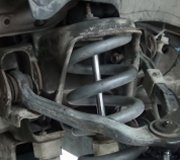If it's a constant clicking noise, look for a shiny "witness" mark on the inside of the wheel to see if perhaps a wheel weight is hitting the upper control arm. I had one where one caliper mounting bolt fell out and the caliper lifted up and hit the inside of the wheel. Rust on the inside of the brake rotor can make a rough, muffled grinding sound. If the sound is more of a clunk, suspect the ball joints, but there's one word of warning if you have someone else inspect it for you. Unlike almost all other vehicles in the world, Dakota lower ball joints can have vertical movement between the ball and socket of the lower ball joint. They must not allow any sideways movement, just like all other ball joints. New ones from the dealer will have about 1/8" of play. That would be junk in other vehicles. Aftermarket ball joints from the auto parts stores will usually be tight but it is acceptable for them to develop that vertical wear later. Contrary to everything we've been taught, that play will not cause a clunk that you can hear, and it is not a reason in itself to replace it. If you hear a rattle over bumps, suspect broken anti-sway bar links. If the rattle stops when you hold light pressure on the brake pedal, suspect a loose brake pad or broken anti-rattle clip. If you can't find the source of the noise with an inspection, there is a tool called the "Chassis Ear" that will help. It is a set of six microphones, headphones, and a switch box. You move the microphones around and switch between them to find the source of the noise. Many mechanics have never heard of this tool or even seen it, but you might be able to borrow or rent one from one of the auto parts stores that borrows tools.
Saturday, March 19th, 2011 AT 10:39 PM


